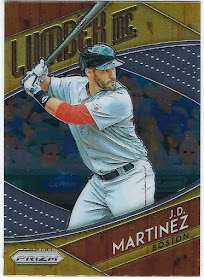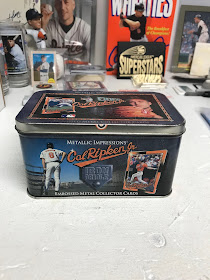Since the brand's revival in 2014, Topps Stadium Club has become a favorite among Baseball card collectors, specifically bloggers who are encapsulated by the minimal base design and gorgeous photography.
Frankly, it's hard to believe that Topps has already released 6 Stadium Club sets since they brought the product back. Even though we generally know what to expect from the release year after year, even as far as the checklist is concerned, Topps never fails to blow me away with the sheer caliber of the images.
The Stadium Club set design, although not the focal point of the product, is essential to how the cards look and how the beautiful photographs are utilized. This year's design is a step up from the 2018 version, for the text doesn't interfere with the images whatsoever.
I mentioned in yesterday's post that I'd be opening an entire hobby box of 2019 Topps Stadium Club, something that's become a bit of a tradition for my Dad and me to do.
We may not have landed any major hits or valuable cards, but Stadium Club is one of my favorite sets solely because of the photography, not for any other reason. It would be nice to land a big-name autograph, but that's not my priority when it comes to this release.
In case you haven't heard, there are no black and white photos in Stadium Club this year, something that may or may not continue in subsequent releases. My initial pack didn't deliver any old-time players, but I'm pleased that I was able to pull a couple of cards with black and white photos that have been enhanced into full color.
Babe Ruth and Johhny Mize are the 2 standouts out of all the players I landed who played in the pre-war era, the other being Honus Wagner. Topps' designers already have to enhance the quality of pictures of guys like Ruth, so I can only imagine what it's like to turn that photo into a color image.
A reasonable number of my 250 player collections include stars from the 70s and 80s, players that appear in Topps Stadium Club each and every year. While Eddie Murray hasn't been in an SC checklist since 2016, the other 3, especially Rickey Henderson, have appeared consistently since the brand's revival.
The Sandberg image is a beautiful shot of Wrigley from the 1980s while the 2 Orioles (Murray and Robinson) have banners in the backgrounds of their respective cards. I'm not sure if the pictures are from Opening Day, the World Series, or possibly the All-Star game.
Speaking of Murray, I love that he makes an appearance on Rickey Henderson's card, for cameos like that aren't too common as far as Baseball cards are concerned.
Finally, we have the players of today, paired with unparalleled photographs from all different angles of the ballpark. Unlike Topps Flagship, for example, Stadium Club goes beyond the typical photos for batters and hitters as well as the repetitive angles for each and every shot.
Instead of showcasing Chris Sale during his windup for the 100th time, let's use a shot of him with his cap off with Fenway Park in the background. Let's use a traditional photo of German Marquez but instead zoom out, using an angle that we rarely see.
This is the mindset behind the masterminds of Stadium Club, a product that truly breaks the mold and goes out on a limb. Not to mention, these gambles virtually always pay off.
I've always been critical of Stadium Club's inserts, both from a conceptual and design standpoint. Rarely has Topps combined a brilliant and/or unusual concept with a visually appealing design as far as Stadium Club inserts are concerned.
Even though they're far from perfect, I notice that Topps has improved the appearance of the SC inserts, if nothing else, from 2018 to 2019. Though the theme behind the cards is redundant, the Power Zone inserts look fabulous this year.
Warp Speed is brand new to the 2019 set. While the previous insert had an okay concept and an effective design, the opposite is true for the Mookie Betts card above. The design is average, but I appreciate the idea of having an insert set dedicated to the fastest players in the game.
Previously a Stadium Club insert set from the 90s and early 2000s, Beam Team has been a fundamental part of the revived product since 2014. The top hitters in Baseball are consistently featured in this insert set where the odds of pulling a card are 1 per hobby box.
Because of how uncommon they are, I certainly wanted my Beam Team card to be a player that I collect, so I was pleased when Jose Altuve appeared in one of the packs. Even though there's a lot of room for improvement, Stadium Club's inserts, especially Beam Team, have improved significantly in 2019.
Speaking of 1 per box. you also get 1 chrome card in every box of Stadium Club, a criminally underrated aspect of this set. The base cards are beautiful as is, and they are further enhanced with the chrome card stock, even though the checklist is limited to around 100 cards or so.
I'd be lying if I said that Justus Sheffield was one of my top choices from the Stadium Club Chrome checklist, but I suppose it could've been worse. Although the logo isn't included on the card, he is a rookie, so I might be able to sell this online depending on how he's doing with Seattle.
New to 2019 Stadium Club is the oversized box toppers, another 1 per box element of this set. Like the chrome card, Koufax wouldn't have been my #1 choice, but I have no problems with pulling his oversized card.
After all, he's a legendary Hall of Famer even though I don't collect cards of the 3-time Cy Young award winner. This pull may give me the motivation to start collecting Koufax cards, or I might sell or trade it to somebody else.
For now, however, I'm just going to appreciate how brilliant it is, on Topps' part, to use oversized base cards as box toppers for this set.
I'd be lying if I said I was shocked that I didn't land any big name autographs in my box. They may both be on-card rookie autos, but there's not much to say beyond that.
I've never heard of Adam Cimber before in my life, and I like to say that I follow Baseball pretty closely. Chance Adams, on the other hand, had some upside going into the 2019 season and was somewhat considered to be a ROY finalist, but I don't think he's living up to his hype.
At this point, the only thing I can do with these 2 rookie autographs is what I typically do with my hits; store them safely in my relic card/autograph box and hope for the best.
And because I don't want to end this post on a negative note, here's an awesome card of Vladimir Guerrero.
Topps Stadium Club rules.
























































